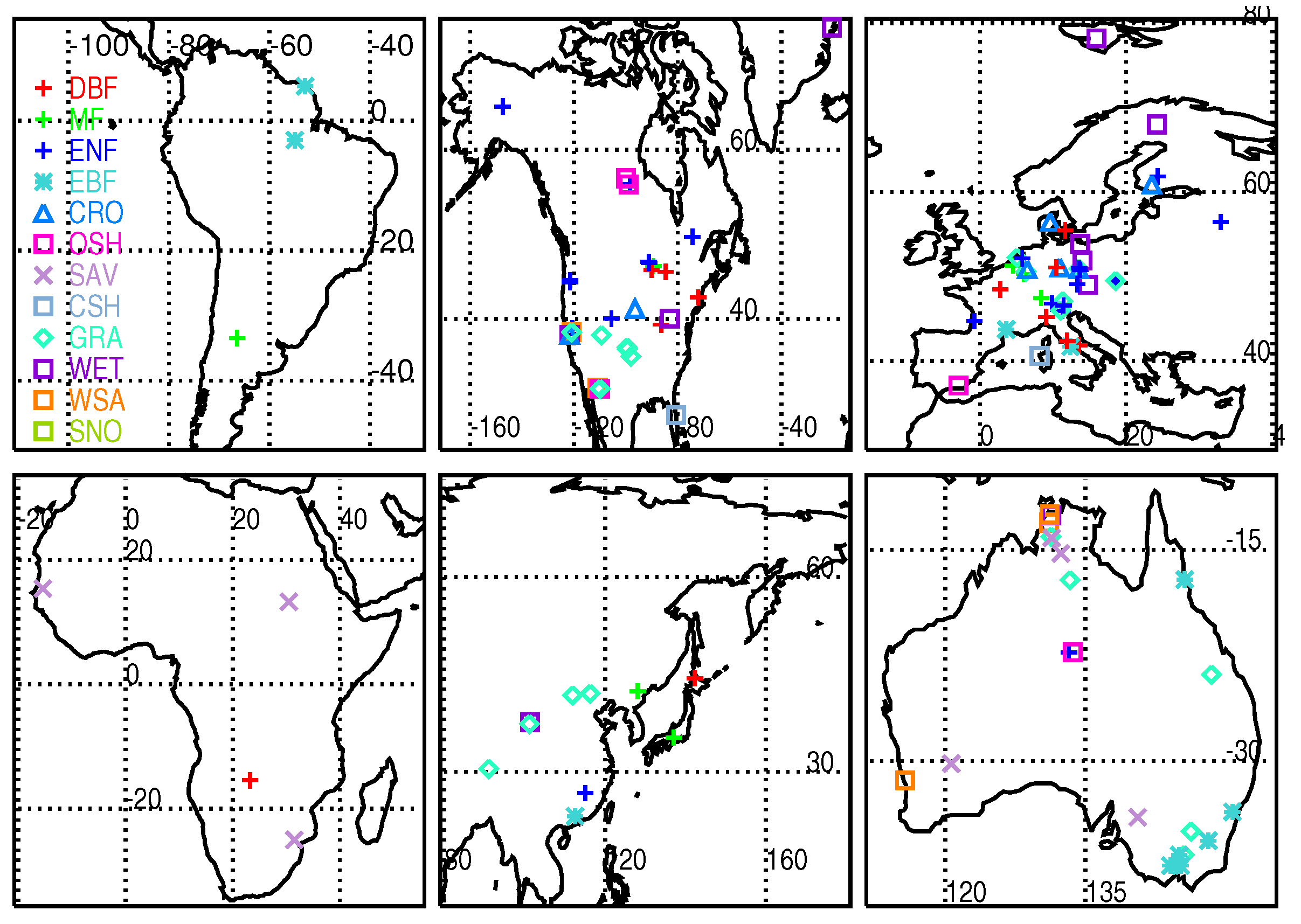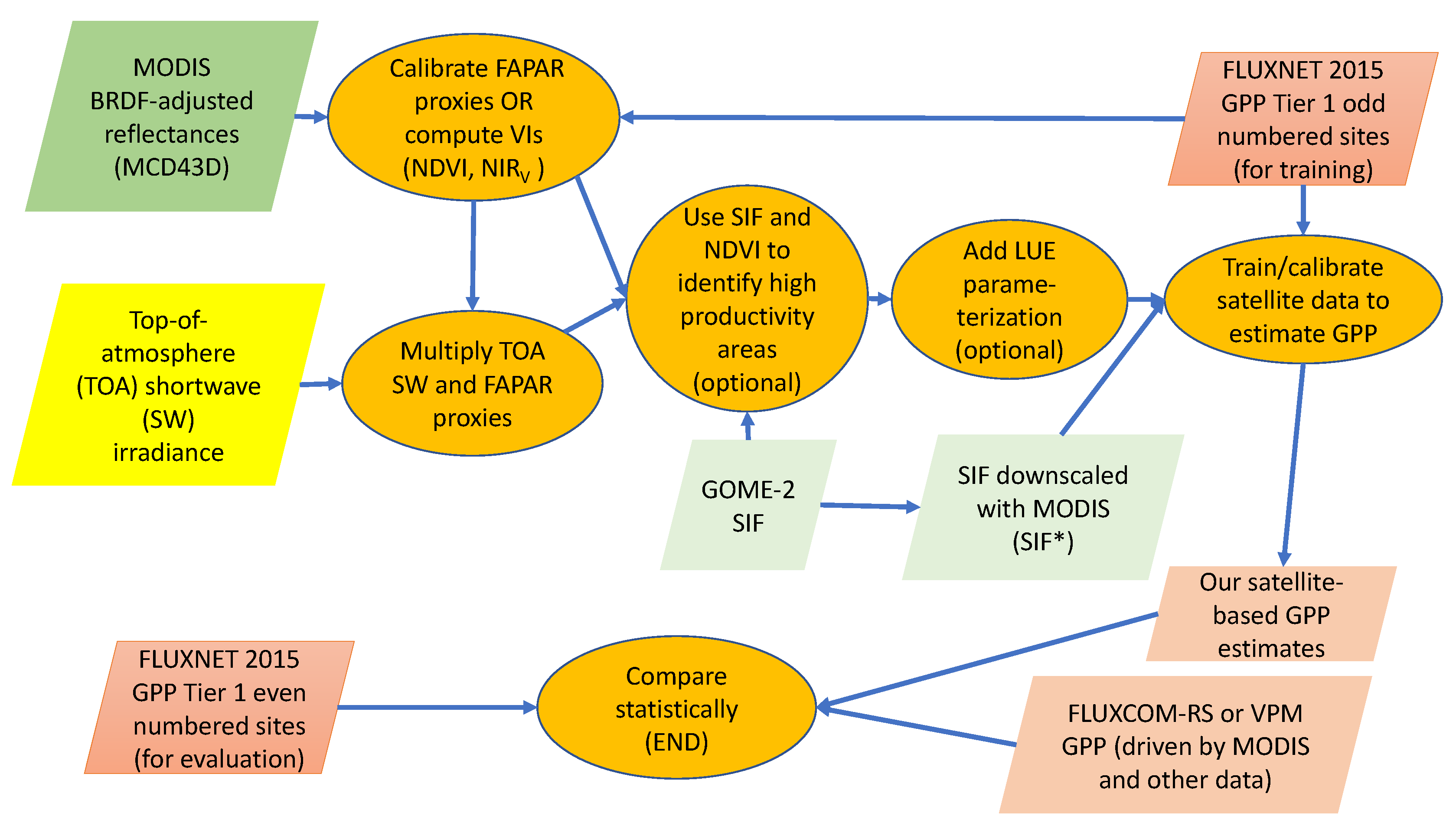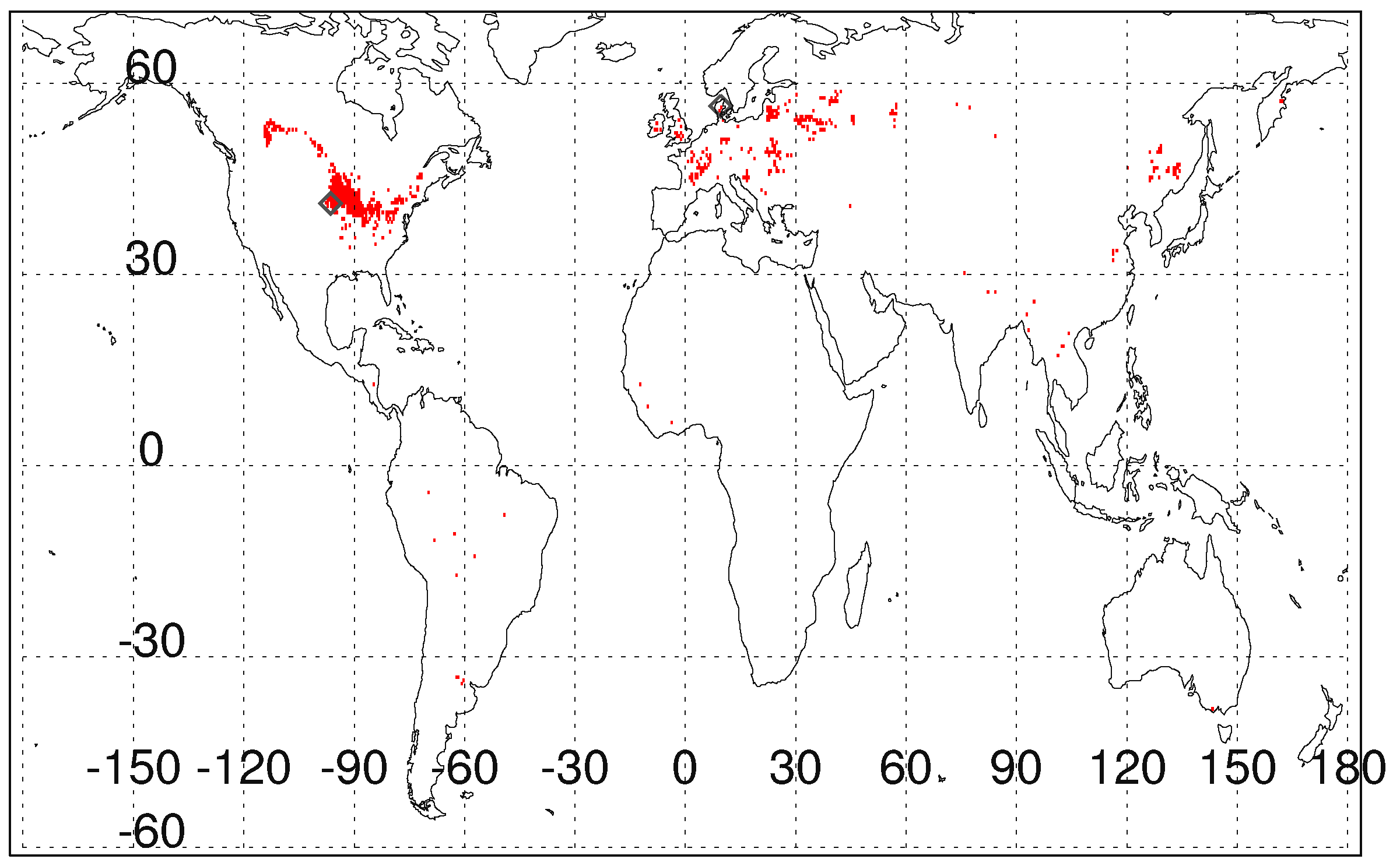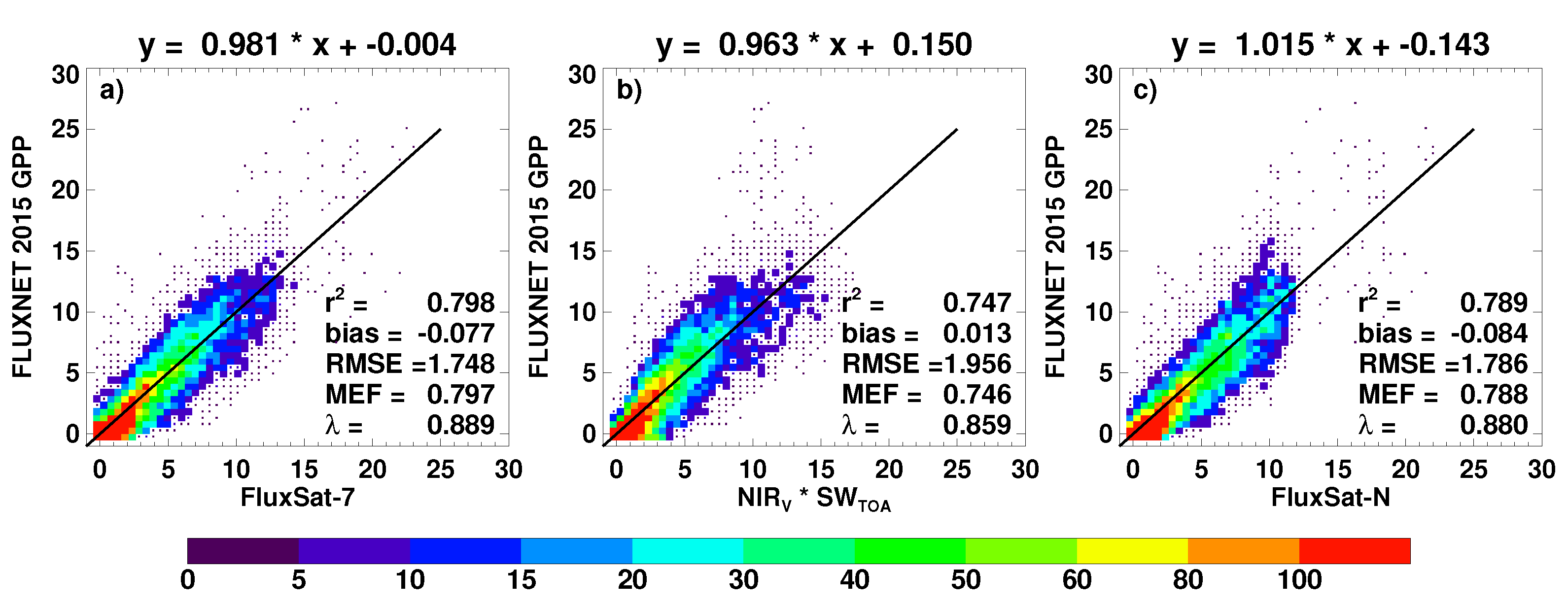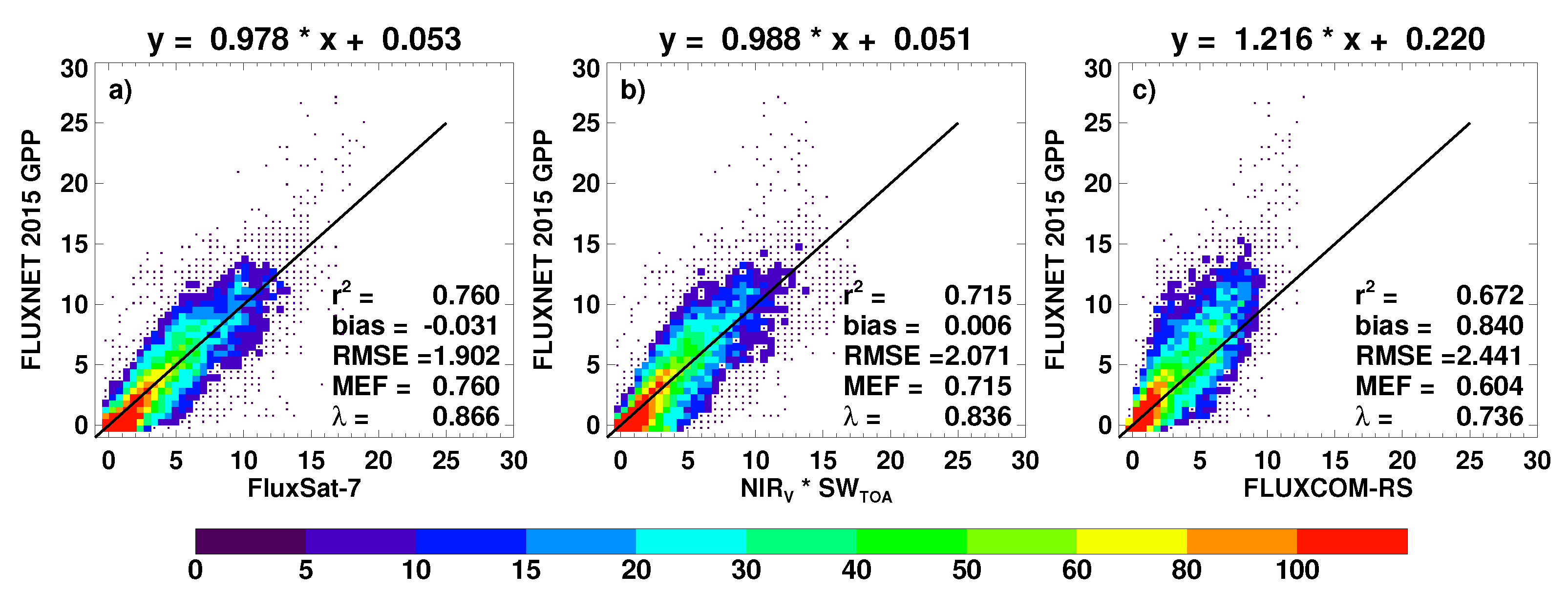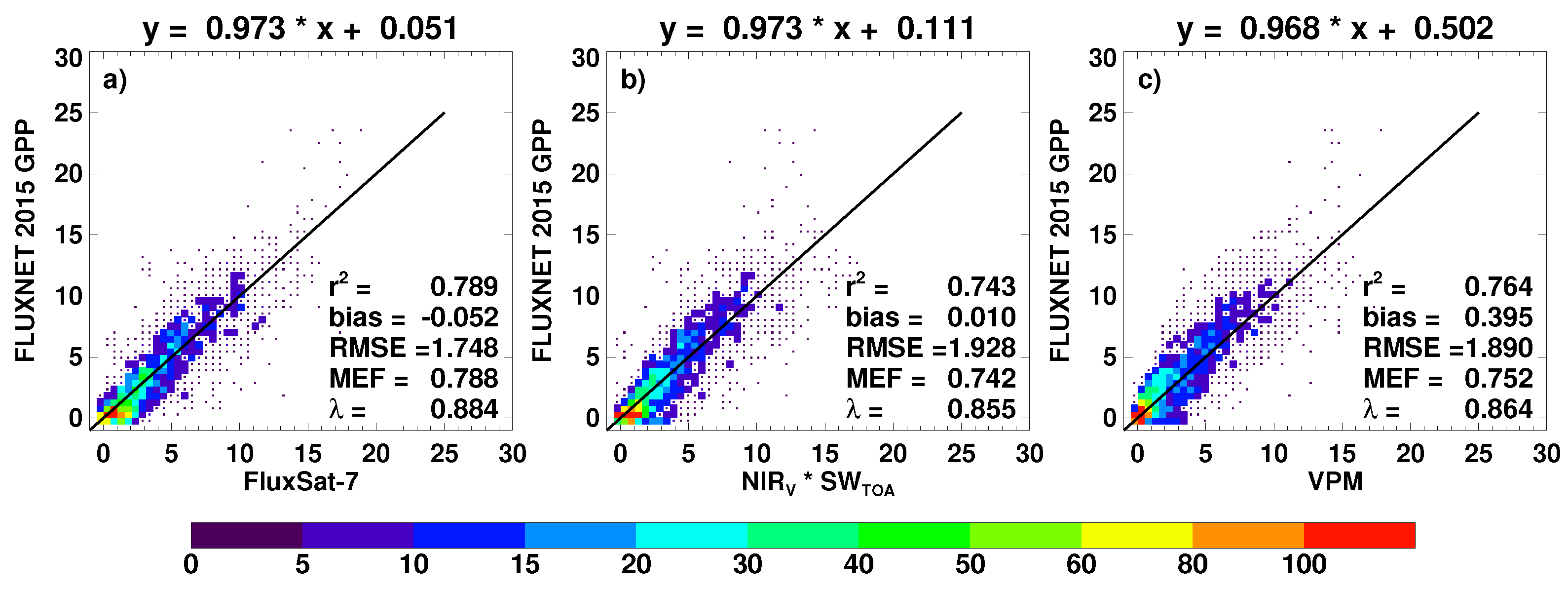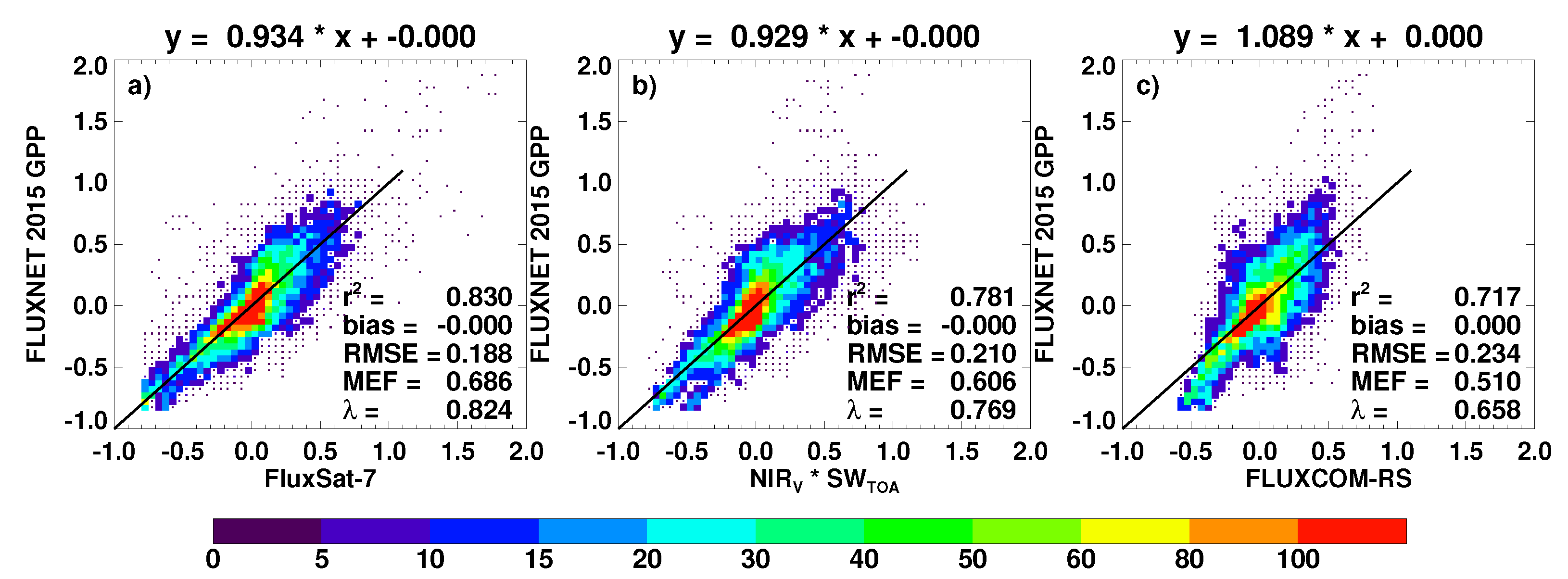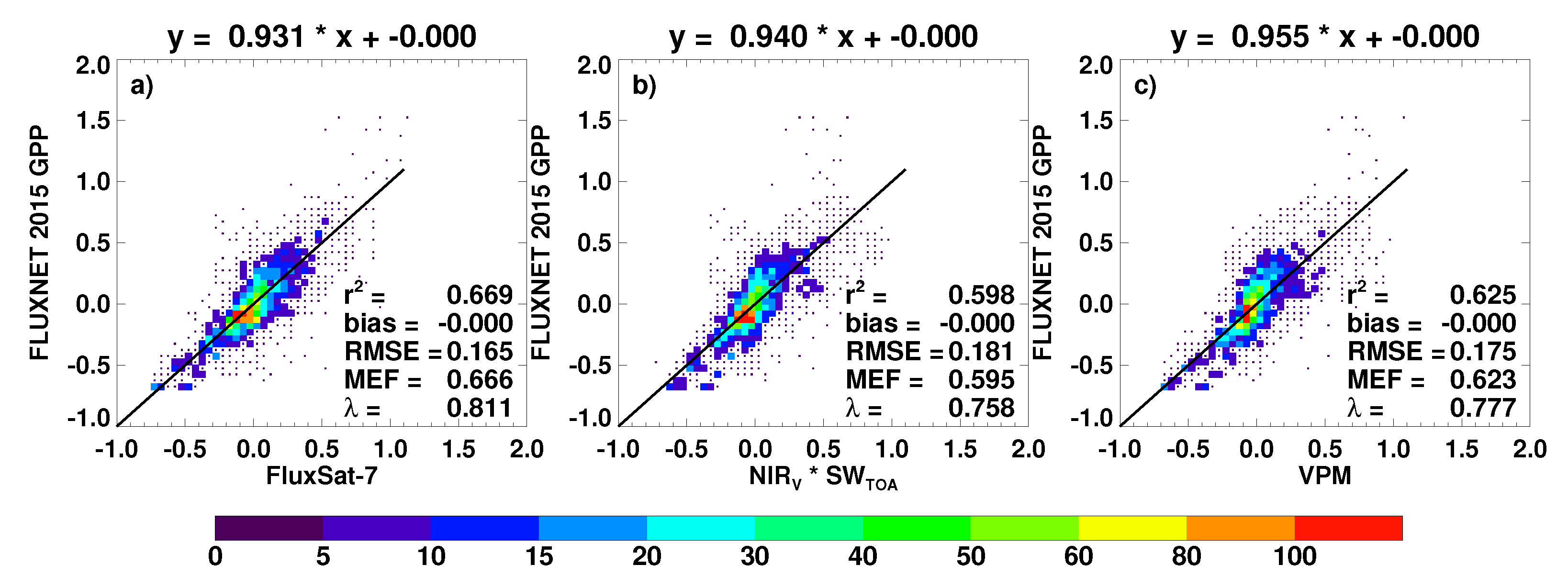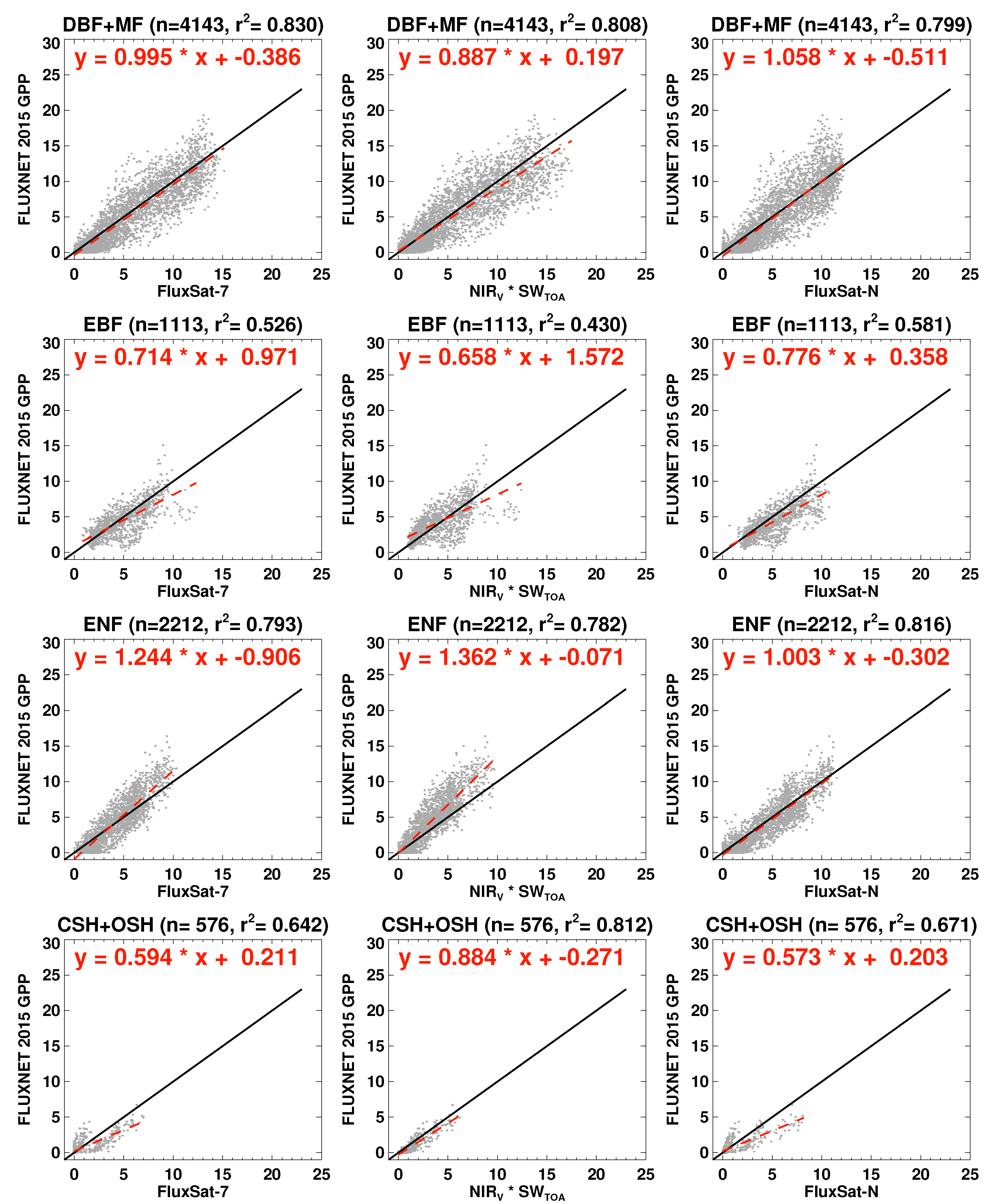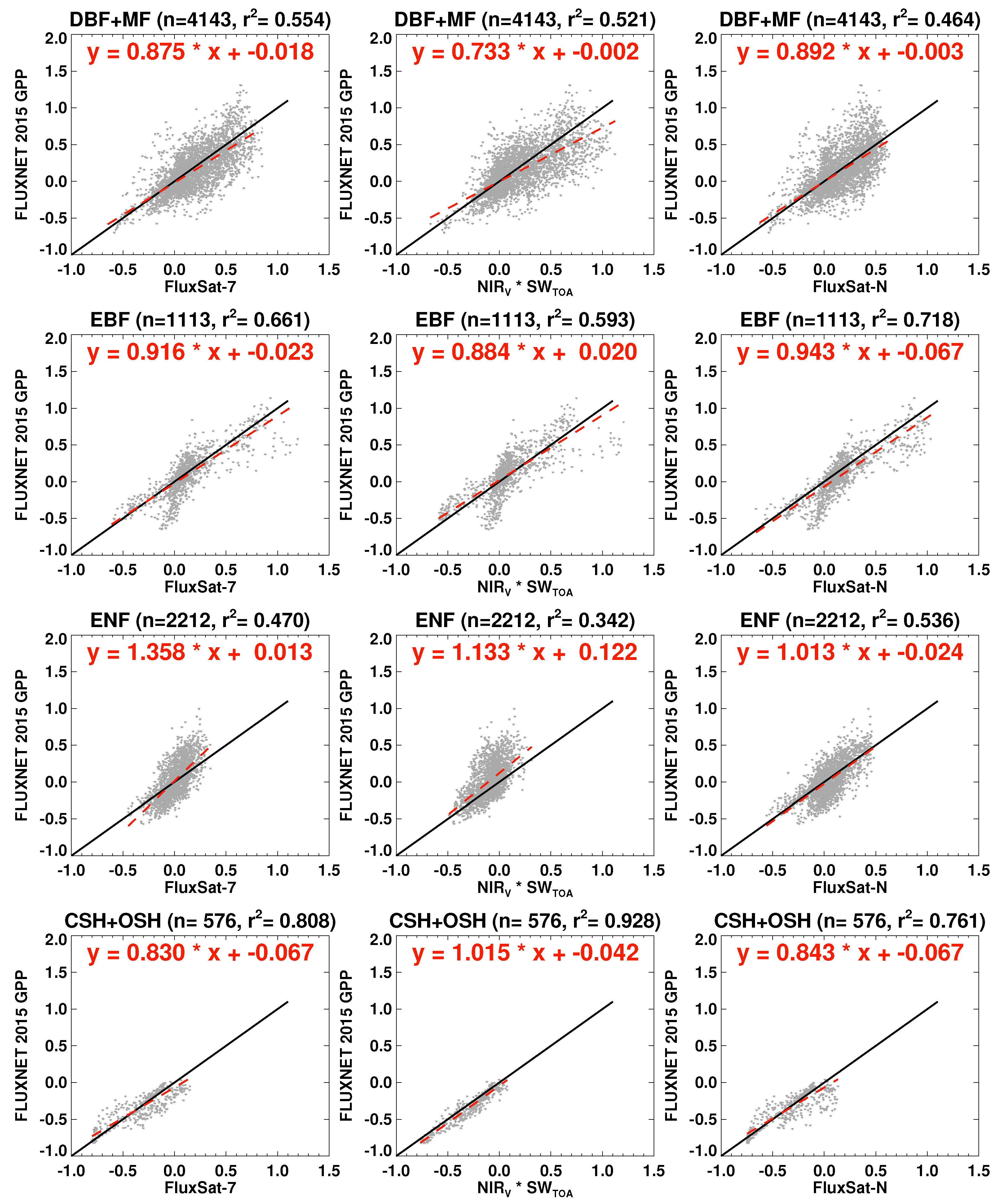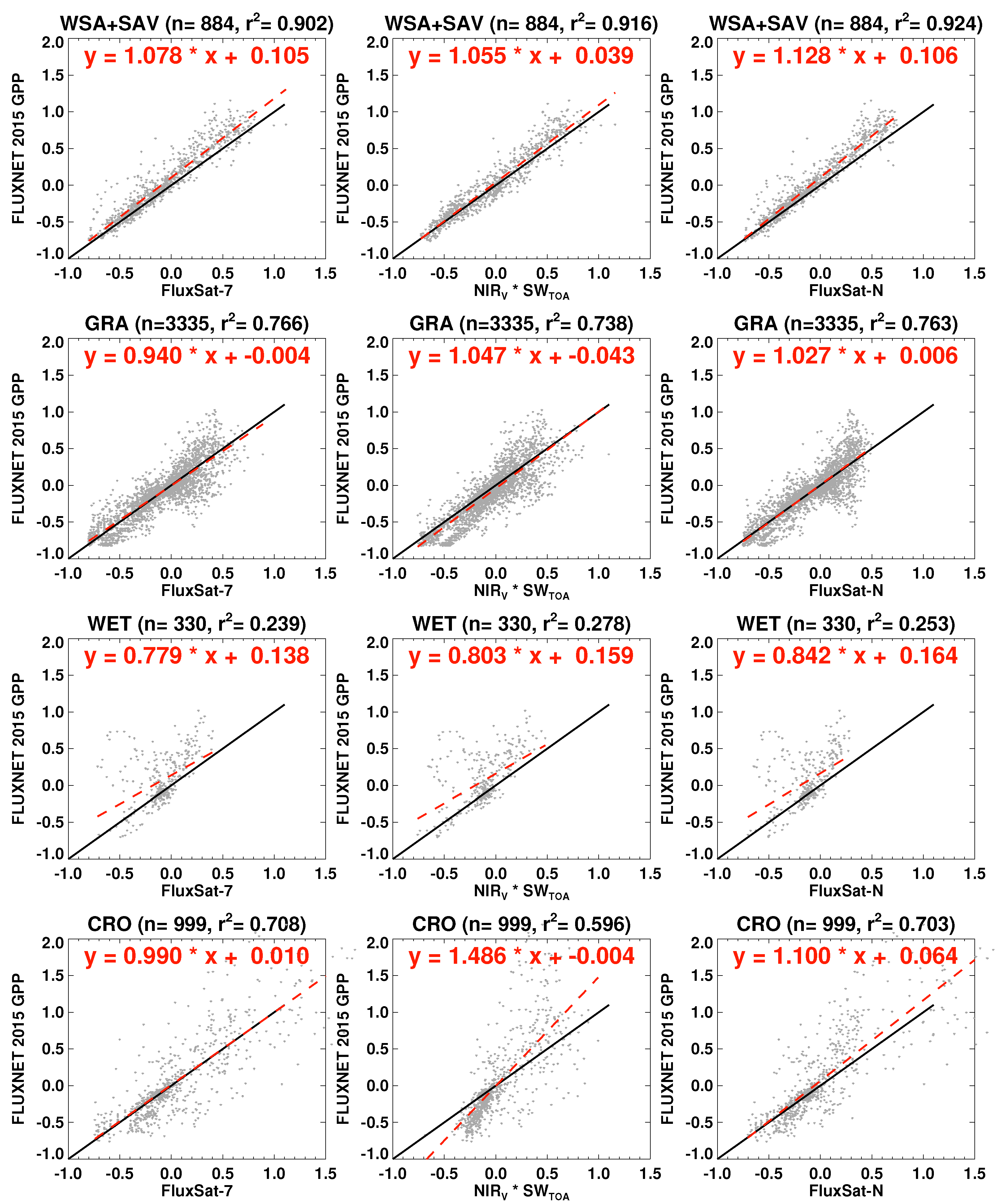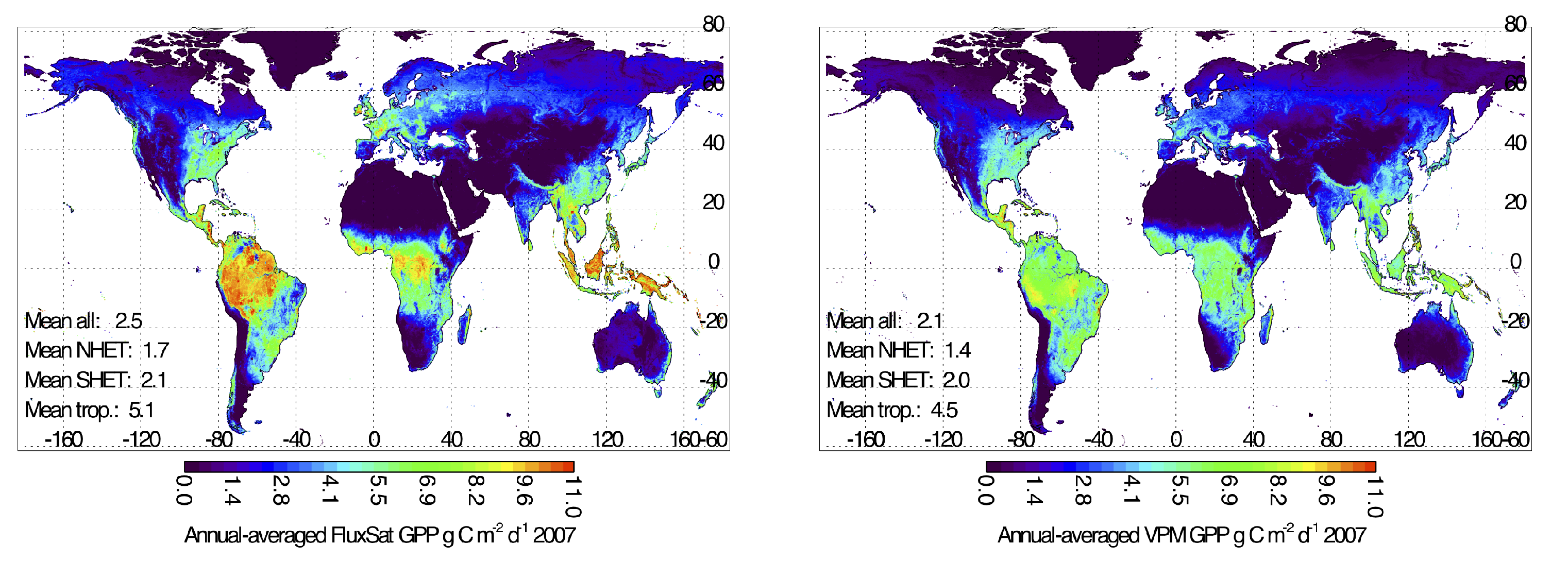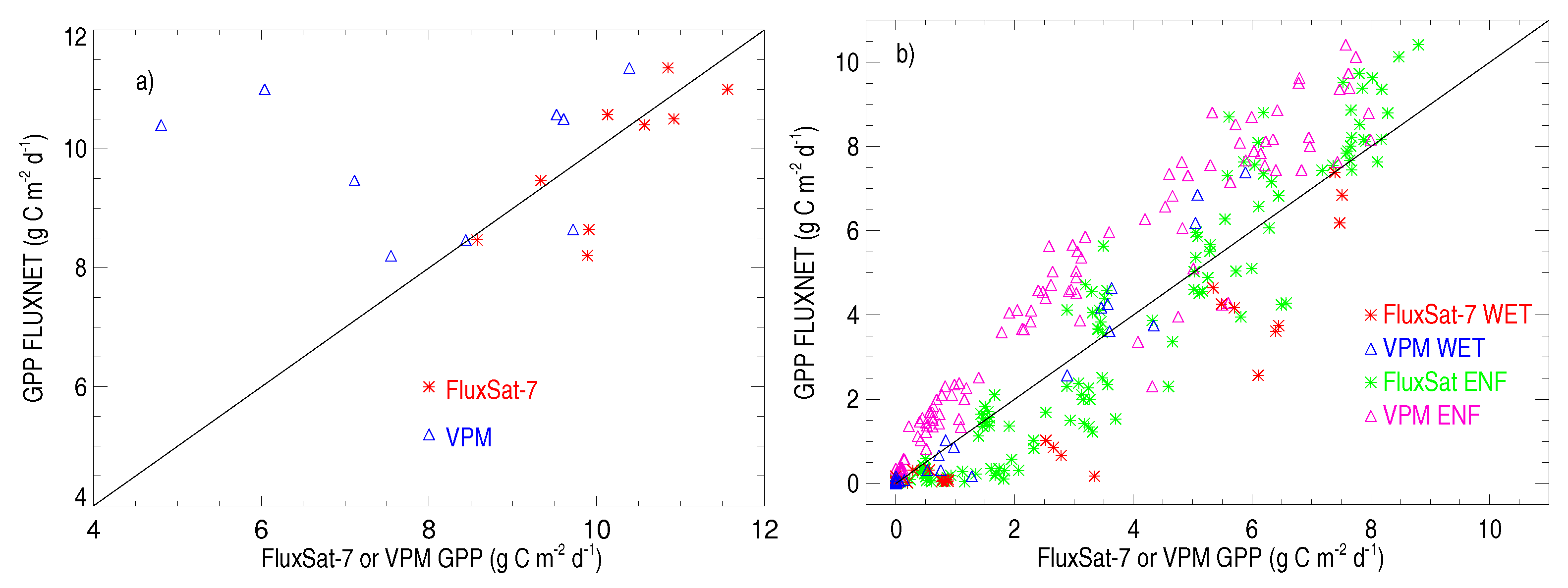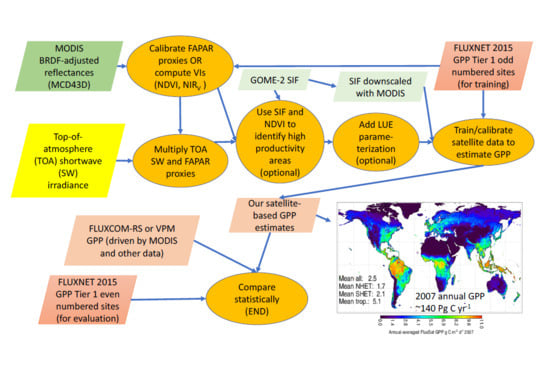1. Introduction
Global terrestrial gross primary productivity (GPP), the amount of carbon dioxide (CO
) that is assimilated by plants through photosynthesis, plays a critical role in the global carbon cycle as it can moderate the amount of CO
from anthropogenic sources that remains in the atmosphere. Despite the collection of ground-based data at hundreds of individual sites, as well as vast amounts of remotely-sensed data from satellites and the development of sophisticated process-based models, there still remains significant uncertainty in global GPP estimates including their global annual mean and inter-annual variability (IAV) [
1]. Estimation of the variability in the land sink for global carbon budget assessments relies upon dynamic global vegetation models that are driven by observed environmental changes [
2]. Peters et al. [
3] note that the understanding of the land sink is currently limited in part by a dearth of spatially-explicit observations of vegetation changes and recommend systematic benchmarking of the models, including productivity, for improvement.
GPP is not measured directly either at the ground or from satellite. Using the eddy covariance technique, tower-based measurements of net ecosystem exchange (NEE) are partitioned into GPP and ecosystem respiration using assumptions regarding the latter (e.g., [
1,
4,
5] and references therein). Despite the assumptions used in this approach, tower-based estimates are considered a standard for GPP estimates. Approaches to scale up these measurements and extrapolate globally involve first deriving relationships between tower-based GPP estimates and parameters from satellite-based instruments and meteorological analyses and then applying these parameterizations globally (e.g., [
6,
7,
8,
9,
10]). Tramontana et al. [
9] demonstrated that such approaches that use only remotely-sensed data perform almost as well as the best model that also incorporates meteorological inputs.
Other data-driven approaches to estimate GPP globally use satellite data in combination with models and various assumptions (see for comprehensive reviews [
1,
11]). Many of these are based on the light-use efficiency (LUE) concept [
12,
13], i.e.,
where PAR
is photosynthetically-active radiation incident at the top of canopy and FAPAR
is the fraction of PAR
absorbed by chlorophyll. Several studies have used the LUE model with space-based estimates of FAPAR
or a proxy such as from satellite-derived vegetation indices (VI), PAR
estimates from a data assimilation system or other measurements, and parameterizations of LUE that use meteorological data as inputs to estimate GPP globally or on a smaller scale (e.g., [
14,
15,
16,
17,
18,
19,
20,
21]).
VIs are computed with a limited number of broad-band channels on satellite imagers. VIs that have been used or considered for estimating GPP include the dual wavelength Normalized Difference Vegetation Index (NDVI) [
22] and the Near-Infrared Reflectance of terrestrial Vegetation (NIR
) [
23] that is defined as the product of NDVI and reflectance from the near-infrared channel used in the NDVI. The potential benefit of using VIs for GPP estimation is that they can be simply derived from satellite reflectances. In particular, an NDVI record is available for over three decades [
24].
VIs have been used to compute GPP with an approximation to Equation (
1), i.e.,
(e.g., [
25]) or other similar forms (e.g., [
26]) where VI is used as a proxy for FAPAR
. LUE, here represented as
S, may be treated a constant [
27,
28] or as a more complex function of VI itself [
29,
30] or other parameters where
S may vary with plant functional type (PFT) (e.g., [
31]). Many of these approaches use flux tower data to train or calibrate their models with a limited number of sites or PFTs and have not been tested globally.
Some of the noted problems using VIs are (1) a decrease in sensitivity at high values, particularly in managed croplands (e.g., [
25,
32]) and (2) a positive offset that occurs when photosynthetic activity should be very low or zero (e.g., [
20,
26,
33,
34]) (i.e., these parameters have positive values when photosynthesis is not occurring). Yuan et al. [
35] found that LUE models in general tended to overestimate GPP at low values and underestimate at high values and that most LUE models do not account for the fact that LUE is higher on cloudy days with more diffuse radiation (e.g., and references therein [
36]). However, some LUE model formulations have included the radiation effect on LUE [
37,
38].
Gitelson et al. [
39] and Peng et al. [
40] found that the use of potential PAR (PAR
, i.e., the PAR at top of canopy that would be present in a cloudless atmosphere) in a simple model, i.e.,
produced superior results as compared with PAR
in cropland vegetation. The improvement obtained by the use of PAR
in place of PAR
with constant LUE implicitly accounts for the diffuse radiance effect on LUE by producing an effectively higher LUE at lower values of PAR
. Peng et al. [
40] notes that this model does not account for variations in GPP produced by short time scale (minutes to hours) stresses. They also suggested testing of this model at other geographic locations and for other vegetation types.
Here, we expand on this approach by training and evaluating models based on Equations (
2) and (
3) with available global GPP estimates from flux tower observations. We then test the satellite-based trained model using independent global GPP from flux towers (i.e., not used in the training). This is a simple and computationally-efficient method to estimate global GPP with a limited number of remotely-sensed parameters with a focus of daily to monthly time scales. We specifically examine whether a modified function of NDVI or a linear combination of band reflectances can accurately represent FAPAR
to mitigate the above-mentioned shortcomings of VIs.
We further explore whether satellite measurements of chlorophyll solar-induced fluorescence (SIF) may be used to improve estimation of global GPP. SIF originates from the photosynthetic machinery inside leaves and has been measured with several satellite instruments [
41,
42,
43,
44,
45,
46,
47,
48]. The spectrum of chlorophyll fluorescence is spread over a range of wavelengths with two broad peaks, centered near 685 and 740 nm, referred to as the red and far-red emissions, respectively. Radiative transfer and physiological modeling suggests that canopy-level far-red SIF is strongly related to APAR [
49]. Most satellite SIF studies have been conducted using far-red SIF, and henceforth, in this work, SIF will refer to far-red SIF. Several studies have shown a highly linear relationship between far-red canopy-level SIF and GPP on monthly time scales [
32,
46,
50,
51,
52,
53,
54] that can be explained by modeling results [
55]. Far-red SIF also closely follows seasonal [
33] and daily to diurnal [
54,
56] variations in GPP. SIF measurements also alleviate the above-mentioned short-comings of VIs [
32,
33,
57]. However, unlike VIs, SIF is a very small and difficult to measure signal. As a result, satellite SIF measurements are relatively noisy, prone to systematic errors [
44,
50,
58] and currently limited in terms of both spatial and temporal resolution.
Here, we use attributes of both satellite-based reflectances and SIF in a computationally-efficient way to estimate global GPP accurately at high temporal and spatial resolution. In doing so, we seek to address the question: How much of the variance in GPP can be explained with satellite-derived quantities using a simple observation-based approach, particularly in comparison with more sophisticated approaches? To answer this question, we use GPP estimates derived at eddy covariance flux tower stations from the FLUXNET 2015 database to both calibrate and evaluate our satellite-based models. The results are examined at various temporal and spatial resolutions. We also compare with other data-driven GPP estimates and proxies as benchmarks. This comparison provides some insights into which parameters may be important for machine learning (ML) GPP estimates and ultimately may be used to improve the ML results.
3. Results and Discussion
Using the approach shown in
Figure A1, we tested a variety of products and models using GPP derived from a consistent sample of eddy covariance sites to both train GPP satellite-driven models and evaluate them. A particular satellite data-driven model is given by GPP
, where a model parameter
x, such as NDVI × SW
, is used to predict flux tower estimates of GPP and
b is determined by fitting to a subset of flux tower data.
We investigated the impact of using different MODIS datasets in
Appendix A. Generally, MCD43D provided superior results as compared to most other datasets. Our results in the remainder of this paper focus on the MCD43D reflectances that can be used at their highest resolution (∼1 km) or degraded to be comparable to the resolution of other datasets used for benchmarking.
We also tested the use of different radiation datasets in
Appendix C. The use of top-of-atmosphere shortwave (SW
), computed as being proportional to cosine of the solar zenith angle (SZA) integrated over a day, as compared with the satellite-derived all-sky SW produced the best results with Equation (
2) where LUE was assumed constant. These results are consistent with those of Gitelson et al. [
39] and Peng et al. [
40], who used a limited number of flux tower sites. Those studies found that GPP did not follow PAR
, but rather that other factors affect GPP, and that the use of PAR
reduces some of the variability resulting from the dependence of LUE on cloudiness. This would occur if LUE is not constant, but rather anti-correlated with PAR
(or correlated with cloudiness), such that various combinations of PAR
and LUE produce a relatively constant GPP over a range of cloud conditions and for a given fixed value of FAPAR
. It is well known that LUE is higher in situations with more diffuse light (e.g., [
36]) (i.e., cloudy conditions) as compared with clear-sky conditions. One exception is very low light conditions where LUE saturates.
For following comparisons between models and flux tower data, results are typically shown in terms of scatter diagrams or 2D histograms with accompanying statistics. For completeness, we also provide probability distribution functions in
Appendix D. These show the degree to which the differences follow a normal distribution that is assumed in statistical significance tests. While the differences deviated somewhat from normal distributions, the number of samples was large enough in most cases that the significance tests (when
p-values were very small) were assumed to be valid.
3.1. The Use of Downscaled SIF to Estimate GPP
Duveiller and Cescatti [
67] showed that SIF* agreed better with flux tower GPP as compared with MOD17 GPP (see
Appendix A for a description of MOD17). Here, we further evaluate SIF* by comparing it consistently with the results of our models. We first verified that all of our models also outperformed MOD17 GPP on eight-day to monthly time scales in all statistical measures. Note that because SIF depends upon incident radiation, we did not explicitly use PAR in SIF-based models (other than to normalize it appropriately as described above); here, we simply applied a single scaling factor to SIF* at monthly time-scales to estimate GPP globally. The assumption of a single scaling factor to relate SIF to GPP, at least encompassing many plant functional types, has been suggested [
53,
74]; however, the use of a single scaling factor was not generally supported by previous studies (e.g., [
46]).
We examine monthly SIF* along with NDVI
and NIR
results in more detail in
Figure 3 by comparison with tower-derived GPP for years 2007–2013 when GOME-2 SIF v25 data were available. Note that the resolution for SIF* was 0.05
, while the MCD43D reflectances had been resampled to 0.083
; note that the MCD43D results were degraded as compared with the ∼1 km
results in
Table A5, which were much closer to the footprint of the eddy covariance technique [
34]. While the positive SIF* bias was clearly seen at GPP values near zero, SIF* was shown to have a more dynamic range as compared with the NDVI
-based GPP estimates; NDVI
-based GPP estimates tended to saturate at around 10 g C m
d
; while SIF* and NIR
-based estimates reached values close to 15 g C m
d
. SIF* appeared somewhat noisier than the NDVI
- or NIR
-based GPP estimates. This was expected as the downscaled SIF was directly tied to the more coarsely-gridded GOME-2 SIF that was inherently noisy due to the very small SIF signal. Correlations were significantly different between all three models (i.e., null hypothesis rejected) with
p-values
.
The apparent noise in SIF* may also have resulted from the effects of vegetation structure on the escape of SIF through the canopy [
75,
76]. We attempted to account for the variations in canopy escape as suggested by Yang and van der Tol [
76] using MODIS Band 2 (near infrared) reflectance for normalization. However, we did not find improvement in the global statistics. One explanation is that the approach may not work well when bare soil contributes significantly to the observed reflectance and/or because the wavelengths of the MODIS reflectances are not optimal for this purpose.
While the SIF* results were noisy as compared with reflectance-based approaches, we were encouraged by these initial SIF* results given that only a single scaling factor was applied. We expect improvements in subsequent versions of SIF* that will use more recent datasets for SIF, as well as the high spatial resolution variables employed for downscaling. In addition, we expect progress to be made in developing methods to account for the effects of vegetation structure on SIF escape from the canopy globally.
3.2. Use of Linear Combinations of Bands Rather Than VIs
Figure 4 shows results at an eight-day temporal resolution and the highest spatial resolution used here (0.0083
) for two- and seven-band models where linear combinations of bands were used as FAPAR
proxies according to Equation
7. Both band models provided improved dynamic range in estimated GPP as compared with the NDVI
-based model, and the correlation improvements were statistically significant with
p-values < 0.025. The seven-band and two-band models were not statistically distinguishable. All models underestimated GPP at the highest GPP values.
3.3. Use of SIF to Delineate Highly Productive Agricultural Areas
One vegetation type for which GPP was not well predicted by our global linear regression models is croplands with GPP
15 (see
Figure 3b and
Figure 4). An examination of these points shows that they are primarily from three sites in the U.S. Corn Belt (US-Ne1, US-Ne-2 and US-Ne3) that are frequently planted with maize, a C4 plant. Zhang et al. [
21] used various datasets to compute grid box fractions of C4 plants (natural and agricultural) for the VPM and defined different maximum efficiencies for C3 and C4 plants within their LUE formulation. The datasets used to compute C4 fractions were static (i.e., no interannual variability) and at lower spatial resolution than the VPM datasets.
Here, we explore an alternative approach that uses satellite-based SIF to delineate highly productive regions. Guanter et al. [
32] demonstrated that SIF was more highly correlated with GPP than EVI at flux tower sites located in the U.S. Corn Belt because EVI, like NDVI, displays saturation at high values. They also showed that data-driven models, such as the predecessors of FLUXCOM-RS, did not produce the very high values of GPP derived from flux towers in this region. Global maps of SIF show very high values in summer in these same regions, while NDVI and EVI do not [
32]. Here, we test the use of SIF observations, albeit at low spatial resolution (0.5
), to identify these regions of high productivity not prominent in the NDVI that may be related to large fractions of highly productive crops that are not well captured by the reflectances alone.
Using collocated GPP, SIF and NDVI data, we found that the FLUXNET 2015 sites with high maximum GPP values that were not well fit using our single linear regression models displayed the following criteria of high NDVI and a large ratio of SIF to NDVI when normalized appropriately by PAR: specifically, NDVI
0.76 and SIF
/(NDVI
3.0, where
t is the month with the highest climatological value of NDVI and
is the average solar zenith angle for that month corresponding to the GOME-2 SIF observations. The climatological monthly means are computed over the years 2007–2016.
Figure 5 shows a map of the areas detected with this approach. Adjusting the thresholds upwards resulted in somewhat less flagging over areas outside the U.S. Corn Belt (e.g., Eurasia) and vice versa. Additional flux tower sites in high productivity agricultural regions may help to further constrain the thresholds.
To improve GPP estimates with the simple linear regression approaches, we separated the flux tower data into two different samples, one meeting the above criteria for high GPP and SIF and the other not. We then performed separate linear fits to the GPP data for these two subsets. The designated high productivity sites included in the training set were US-Ne1, US-Ne3 and DK-Fou, and the only site in the validation dataset was US-Ne2.
Table 2 shows the results of the validation from this dual fit approach, henceforth referred to as NDVI
or 7band
. The statistics shown here are for daily data. We note significant improvement in metrics with flux tower GPP with dual fit as compared with the single fit models (null hypothesis rejected). These results demonstrate a clear capability of the satellite data to estimate GPP down to a daily time scale. Note that for the band models, the coefficients for each band in the calculation of FAPAR
proxies in Equation (
7) were estimated using all flux tower training data. Only the slopes between GPP and the product of FAPAR and PAR proxies were computed using the two different samples.
Even though the results using SIF were positive, there is room for improvement. The use of a low-resolution static SIF dataset has obvious limitations. We do not account for the fact that only a fraction of our identified high productivity grid boxes was covered by highly productive crops. Improved SIF datasets are expected in the near future that will address some of these concerns as explained below.
3.4. Further Parameterization of LUE
Bauerle et al. [
77] found that photoperiod explained more seasonal variation in leaf photosynthetic capacity (related to LUE) than temperature. Zhang et al. [
78] also derived a seasonally-varying photosynthetic capacity from satellite SIF and other measurements and showed that using this seasonal variation within a canopy transport model improved estimates of GPP and LUE. Functions of NDVI have been used to account for these seasonal variations in LUE [
29,
30].
We tested various expressions of seasonal variation of LUE in an attempt to further improve our satellite-based GPP estimates. We found that a small portion of the remaining variance in LUE can best be modeled as a simple polynomial expression of NDVI. In this model, we have for each of the two separate fits within the dual fit approach,
where FAPAR
is an FAPAR proxy such as NDVI
or multi-band proxies. Other LUE parameterizations tested included second order polynomials in SW
, SW
max(SW
), or NDVI/max(NDVI) for each location as proxies for photoperiod or products of these predictors. However, the straight NDVI parameterization provided the best results.
Figure 6 shows results for our dual fit seven-band variable LUE (Equation (
11)) models that we will refer to as FluxSat-7, the dual fit NDVI
-based variable LUE model (FluxSat-N), as well as NIR
-based results at eight-day temporal resolution. At the 0.00833
spatial resolution of MCD43D, both FluxSat-7 and FluxSat-N were more centered about the 1:1 line than the NIR
-based model, and correlation differences between FluxSat and the NIR
-based models were statistically significant with very low
p-values. The FluxSat-7 correlation improvement over FluxSat-N was significant with a
p-value of 0.05. Improvements were obtained with the NDVI-dependent LUE as compared with the results in
Figure 4.
3.5. Comparison with Other Satellite Data-Driven GPP Estimates
Next, we compare FluxSat-7 and NIR
-based GPP with that from state-of-the-art data-driven FLUXCOM-RS and VPM.
Figure 7 shows 2D histograms of FluxSat-7, NIR
-based and FLUXCOM-RS eight-day GPP estimates at 0.0833
resolution versus independent FLUXNET 2015 data. At this spatial resolution, all three generally overestimated GPP at low values and underestimated at high values. FluxSat-7 had the best performance at the highest values of FLUXNET 2015 GPP. All correlations were statistically different (
p-values < 0.0001). FluxSat-7 showed the highest overall correlations with respect to FLUXCOM 2015. As shown above, comparisons with FLUXCOM 2015 at the full spatial resolution of MCD43D (0.0083
,
Figure 6) provided superior results as compared with results at the spatial resolution of FLUXCOM-RS (0.083
).
We note that FLUXCOM-RS was not trained with FLUXNET 2015 data, but rather with a different processing of an overlapping subset of eddy covariance flux tower data from the La Thuile dataset [
10]. This may explain the bias of FLUXCOM-RS with respect to FLUXNET 2015 that was not present with respect to the La Thuile training dataset [
10]. The bias may be easily removed using a linear regression with respect to FLUXNET 2015. When this was done, we obtained statistics that were similar to the single fit models presented in
Section 3.2 applied at the same spatial resolution; the highest GPP values from the US-Ne3 site were still not well matched with FLUXCOM-RS after this adjustment.
Figure 8 similarly shows 2D histograms for monthly GPP averages for VPM, FluxSat-7 and NIR
-based versus FLUXNET 2015. Again, all models reproduced the tower-based GPP estimates reasonably well. As expected, results were improved as compared with those at lower spatial and higher temporal resolution in
Figure 7. FluxSat-7 showed a somewhat lower spread and a bit less underestimation at high GPP values with statistically-significant improvements in correlations over the other two models.
3.6. Comparison of Interannual Variations (IAVs)
Figure 9 and
Figure 10 show 2D histograms similar to
Figure 7 and
Figure 8, but this time of normalized GPP differences from the climatology (also known as anomalies or IAVs). To compute the normalized IAVs, the seasonal cycle of GPP was first removed, then the remaining differences were normalized by the range of observed climatological values from the FLUXNET 2015 data for each individual location (known as the min-max normalization). For example, a normalized value of 0.5 means that a positive difference is 50% of the range of observed GPP. If the min-max normalization was not performed, then analyses suggested that the models did not capture IAVs well.
All models were able to reproduce GPP IAVs well. FluxSat-7 provided improved results as compared with the other models. This was the case particularly for the points with the largest IAVs (both positive and negative). All correlations were different with high statistical significance.
3.7. Comparison of Spatio-Temporal Variation in GPP
Figure 11 examines the spatio-temporal variation in annual GPP produced by the different satellite data-driven models. Each point on the scatter diagrams represents a mean annual value for a particular site and year where only the independent sites (i.e., not used in training of either NIR
or FluxSat-7) are shown and all datasets are at 0.0833
resolution. Only complete or nearly complete years (i.e., a few missing eight-day segments) are shown, and the same sampling was done for all datasets (i.e., if there was a missing data point for one dataset, it was eliminated for all datasets). The metrics were best for FluxSat-7, but the model differences were not statistically distinguishable in this case.
3.8. Comparisons across PFTs
Scatterplots of satellite data-driven GPP estimates (FluxSat-7, NIR
-based and FluxSat-N at the highest MCD43D resolution of 0.0083
for eight-day data) versus flux-tower estimates are displayed for different PFTs in
Figure 12 and
Figure 13. All three models showed good performance and relatively low biases across PFTs. On the whole, FluxSat-7 outperformed the other two models with higher correlations and slopes generally closer to unity. NIR
-based had the most dynamic range for deciduous broadleaf forest (DBF) + mixed forest (MF), followed by FluxSat-7; FluxSat-N showed the smallest range for this type. However, FluxSat-7 and FluxSat-N better reproduced the very high values of GPP found in some cropland sites as shown above.
Figure 14 and
Figure 15 similarly compare IAVs across PFTs. Again, all three models effectively capture IAVs across PFTs. The models perform particularly well in capturing IAVs for savannas and grasslands. Upon further investigation of the EBF anomalies, we found two distinct clusters of points. The first cluster was for the Australian sites. The anomalies of these sites were well captured by the satellite data-driven models. The second cluster was for two European EBF sites (FR-Pue and IT-Cpz); anomalies from these sites in FLUXNET 2015 were not well captured by our satellite data-driven models.
3.9. Comparison of Globally Mapped GPP
Figure 16 shows globally mapped FluxSat-7 and FLUXCOM-RS GPP for two eight-day periods in 2007. As expected based on Guanter et al. [
32], large differences are shown in the U.S. Corn Belt and other highly productive agricultural areas identified with the SIF data. GPP values near the peak of the northern hemisphere growing season (for the eight-day period starting at 193) are seen to be generally higher with FluxSat-7 as compared with FLUXCOM-RS; this may be related in part to the different training datasets used. Differences in the winter hemispheres are more similar. FluxSat-7 provided mostly higher values in the tropics as compared with FLUXCOM-RS.
Figure 17 shows maps of annual averaged GPP from FluxSat-7 and VPM. The average values in the Southern Hemisphere extra tropics were similar. However, mean values in both the tropics and Northern Hemisphere extra tropics were higher in FluxSat-7.
To check our results in the tropics, we ran an experiment where half the sites were used for training, but the one tropical station with high GPP values from FluxSat-7, BR-Sa3, was withheld from the training set and was instead used for evaluation.
Figure 18a shows that the high GPP values for this site produced by FluxSat-7 were supported by the flux tower values. This is an important finding because this region is frequently cloudy and satellite-derived GPP values have large uncertainties owing to few ground-based training sites.
We similarly compare GPP values at four independent high latitude sites (above 60
N) in
Figure 18b where two sites were ENF and two were wetland. We see that both FluxSat-7 and VPM underestimated GPP at the higher values for ENF sites, while FluxSat-7 somewhat overestimated for wetland sites and lower GPP values at ENF sites. VPM had a more consistent underestimation
The annual GPP values from FluxSat-7, VPM and FLUXCOM-RS were 140.8, 125.0 (in agreement with that reported by Zhang et al. [
21]) and 111.6 Pg C y
, respectively for 2007. If SIF was not used for delineation of high productivity areas, and a single fit to the flux tower data was used for all areas, then FluxSat-7 reduced to 139.4 Pg C y
. It has been noted that VPM has an underestimation for ENF and EBF that is possibly related to higher light use efficiency for diffuse radiation [
21]. It is therefore not surprising to see higher values from FluxSat-7 as compared with VPM for those PFTs that occupy a significant fraction of the vegetated land surface.
FluxSat-7 is within the range of a compilation of observation-based, model, and hybrid results [
1], but outside the high range of values from previously reported observation-based diagnostic models [
79]. Discussing the evaluation of global annual GPP produced by Earth system models with an earlier version of FLUXCOM (that produced a value of 119 ± 6 Pg C y
), Anav et al. [
80] noted that higher estimates of 150–175 and 146 ± 19 Pg C y
were reported by Welp et al. [
81] and Koffi et al. [
82], respectively, though there were large uncertainties associated with those estimates. How our observation-based GPP values are interpreted within the context of the land sink and budget imbalance in global carbon budget estimates that rely upon dynamic global vegetation models [
2] will be a topic for future investigation.
4. Conclusions
Here, we have presented a suite of satellite data-driven models based on the LUE concept to estimate GPP globally. The models were trained (or calibrated) using a subset of eddy covariance flux tower data and evaluated using a set of independent flux tower data. The models did not have any explicit dependence upon PFT; they were trained and evaluated with data across all PFTs with the exception of sites with high SIF relative to NDVI that were trained separately and generally coincided with high fractions of C4 maize crops. These areas represent only a few percent of the total land surface. Our best satellite data-driven models outperformed more complex state-of-the-art data-driven models that may or may not also incorporate ancillary information such as meteorological data.
We find that using SW (similar to clear-sky SW radiation) with constant or slowly varying (on seasonal time scales) LUE effectively accounts for the dependence of LUE on incident (cloudy-sky) radiation; specifically, light use efficiency increases with cloudiness index or diffuse radiation fraction in such a way as to produce a relatively constant GPP over a wide range of cloud conditions, and our model effectively accounts for this. This may explain why our GPP estimates are higher than other satellite-based estimates, particularly in the cloudy tropics. Our high derived GPP values in the tropics agree well with the one available tropical Tier 1 FLUXNET 2015 site that has high values. Higher values of estimated GPP in the tropics and also in the extra-tropical Northern Hemisphere lead to higher annual estimated values of GPP (140.8 Pg C y for 2007) with our best model. This is higher than other state-of-the-art satellite-based GPP estimates and on the high end of values from both prognostic and diagnostic models.
We applied a relatively simple adjustment to NDVI data to mitigate the NDVI offset. Models that use NDVI or the two NDVI bands have the advantage that they can be applied to satellite data that date back to the early 1980s from the Advanced Very-High Resolution Radiometer (AVHRR) such as from Tucker et al. [
24] or to field-scale imagery from Landsat, Sentinel 2 or other commercial satellites. The linear combination of either two or seven bands provides more dynamic range than the NDVI that tends to saturate at high values.
We find that inclusion of an LUE parameterization in terms of a second order polynomial function of NDVI helps to further explain some variability in GPP. This formulation presumably accounts for variations in the maximum carboxylation rate tied to the photoperiod.
For available input VI-related satellite datasets, we find that better results are obtained when using BRDF-adjusted data as compared with non-adjusted data. We obtained improved results using NDVI computed from averaged reflectances or albedos rather than composited “best-value” NDVI data. We also confirm that in general, better statistical comparisons with the flux tower data were achieved when satellite data are used at high spatial resolution similar to the typical footprint of eddy covariance data (∼1 km) as compared with (5–8 km). In terms of temporal resolution, the best results were obtained at monthly temporal resolution, as expected. However, results at eight-day or daily resolution were only marginally degraded as compared with monthly averages.
The best results were obtained when our models took advantage of satellite-based SIF data to identify areas of high productivity. These models also outperformed the NIR for estimation of global GPP. The results overall with downscaled SIF were encouraging given that only a single scaling factor was used and considering that the input datasets have since been updated. However, to be further improved, it is likely that variations in fluorescence escape from the canopy and fluorescence yield will have to be better accounted for.
The reflectance-based models were able to take advantage of high fidelity imager reflectance data with low noise and consequently high spatial resolution and frequent revisit. Our results suggest that machine learning or other similar approaches may benefit from the use of these data along with SIF. While our approach of using a static low resolution SIF dataset to detect high productivity areas is not optimal and can be improved, the number of grid boxes with high SIF relative to NDVI was only approximately 2–3% of all land grid boxes, excluding Antarctica. Therefore, small errors due to temporal variability or the fact that only a fraction of those grid boxes may contain high productivity crops are unlikely to have a significant impact on our global annual GPP estimates. The results obtained here may be further improved using higher spatial resolution SIF data ideally taken over several years, such as from the recently launched TROPOspsheric Monitoring Instrument (TROPOMI) with ground footprints ∼7 km × 3.5 km at nadir and complete daily global coverage [
65].










